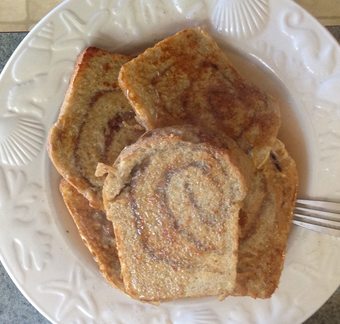 Whole wheat, sour dough, cinnamon swirl French Toast with cinnamon syrup. YUM! Whole wheat, sour dough, cinnamon swirl French Toast with cinnamon syrup. YUM! I will admit, when I supply our pantry with a powdered milk product, it has always been plain and simple, dry milk powder. I have stored both powdered cow milk and powdered goat milk and love both. I have never stored “milk alternatives" for the simple fact that I prefer items that are as close as possible to the original product or its original ingredient base. In other words, I prefer the real thing. Not long ago, though, we had picked up a food storage package deal, and inside was this product called Morning Moo. After reading the ingredients on the label, it was NOT something I wanted to consume on a regular basis, so I tucked it away on a shelf. Why was I hesitant? Several of the ingredients make it a product I would not buy myself. Ingredients from the label: Sweet whey, creamer (coconut oil, corn syrup solids, sodium caseinate [a milk derivative], dipotassium phosphate, sugar, mono and diglycerides, polysorbate 80, sodium silicoaluminate, tetrasodium pyrophosphate, soy lecithin), nonfat milk, sugar, guar gum, vitamin A, vitamin D. Although this list is not as offensive to me as some other products might be, it does contain things we do not normally tolerate on our ingredients lists. Not a fan of corn syrup-anything, sodium caseinate, dipotassium phosphate, mono or diglycerides, polysorbate 80, sodium silicoaluminate, tetrasodium pyrophosphate, or guar gum. That leaves only sweet whey, coconut oil, nonfat milk, sugar and the vitamins that might pass my food approval rating! Not much hope, is it? Well, recently I decided to give it an experimental try, and include a personal real-time product review for those who have bought it in the past, might buy it in the future, or got it in a package deal. To do this I set out to use it in some of the storage recipes I normally do with both powdered milk, raw milk, AND a gallon from the store. Here is what I tried and the summary of final results. ~~~Farm Cheese - At first glance, I thought Morning Moo was an epic fail on making farm cheese. I followed my normal directions using the Moo, but when I added the vinegar, it did not seem to separate into whey liquid and cheese product. When this happens with powdered milk or regular milk, I often just add a little more vinegar to trigger a reaction. I did this, and still nothing seemed to happen. I decided to let it sit until cool (about an hour), and then I would strain it for a final result. I expected there to be no cheese product when I did this an hour or so later. What I discovered surprised me. It actually DID produce almost the same amount of cheese product as I normally get from regular milk. SURPRISE! I had read several sites online that said this would not happen with a milk alternative product. After tasting it, I do know you cannot add as much vinegar as I finally added. This truly makes the cheese taste very tart. Except for this, the results are actually similar to those of my normal farm cheese recipe. Taking away the sour taste from the vinegar, the cheese would actually taste pretty much the same, maybe a touch sweeter, than my farm cheese recipe. There are subtle differences I will mention: It is softer than normal; it is not as “gathered” as normal. Meaning that normal farm cheese seems to form in little clusters or larger “balls” the size of a dry split pea, and on occasion as large as a pinto bean. The finer cheese has always made for a great mimic of ricotta cheese tossed in a salad, as filling for ravioli and in layers of lasagna, while the larger grains we have enjoyed sprinkled on galette or pizza. This Morning Moo farm cheese forms, though, as more of a cream cheese consistancy, but grainy. The “grains” are about the size of sand, maybe a touch larger. As with the original recipe, Morning Moo farm cheese also works well in ravioli or as stuffing for tortellini. When adding to other recipes, it just seems to mix with the oil and vinegar on a salad and runs together with the sauce in lasagna. Not as great for these, but is tolerable in a pinch. As far as using Morning Moo for other recipes and purposes, I experimented with the following: ~~~Pre-cooking dip mix for French toast - When I make French toast, I mix a couple eggs with a splash of whole milk, whip, dip, and fry. This morning we had sourdough cinnamon swirl bread French toast using the Morning Moo mixed with two eggs. I noticed after whipping the mixture, it seemed VERY creamy in comparison to whole milk and eggs. The eggs actually left none of the strange thick white that is often left when I whip the mixture using real milk. It also did not seem to soak as deeply into the bread, which I did like a bit more. Sometimes it seems as if the egg mix soaks in so deeply that the French toast doesn’t cook all the way through to the middle. Because it was more of a surface dip, it actually made the toast crispier as I cooked it. As far as taste, I didn’t notice any significant difference in breakfast. So for French Toast, Morning Moo gets a thumbs up as a decent alternative to regular milk and powdered milk. ~~~In my Morning cuppa - I prefer cream or whole milk in my coffee. I love the rich and creamy depth it adds to hot coffee. I do not like skim milk or mixed powdered milk because both make the coffee taste watery to me - which is difficult to do at our house, because we make our coffee kind of strong! Surprisingly, Morning Moo Milk Alternative did NOT make my coffee watery, and I tried it two ways. I added it as a liquid mixture to my cuppa, and I added it as a powdered “creamer.” It ALMOST mimics the same rich and creamy flavor of real cream or whole milk, but it does have a strange feeling on my tongue after I swallow. This strange feeling seems to be "thin," not heavy, and it dissipates after a moment or two. It seems to be a sort of almost oily film. The flavor of Morning Moo, to me, is not as “real” as chilled cream or whole milk, and it does have a slightly "different" flavor, not quite artificial, but definitely not REAL flavor. All in all, in a pinch, it WOULD be a tolerable alternative to real milk products in my coffee. ~~~As my evening Chai Tea base - I think I would have to say it is about the same as my coffee. I was hoping that maybe it would enhance the flavors of the cardamom and cinnamon, but not terribly impressed. I actually like the spices better in plain water. Sad, but true. My final summary? Morning Moo is NOT my powdered milk product of choice. In fact, if I listed my preferences in order, I would say 1) powdered goat milk; 2) powdered milk (whichever your family finds the most palatable!); then, if there is no other alternative, 3) Morning Moo or other milk alternatives. However, if you have Morning Moo or somehow end up with it, it IS workable into your food storage and emerency food “prepper-toire”. NEXT PROJECT: Will I be able to make the soft cheese into a slightly sweet and creamy spread for bagels? Will it mix with jellies to make a flavored “Creamy cheese fruit spread?" Will update with results that as soon as we find out!
0 Comments
Leave a Reply. |
AuthorJudith has over 20 years experience in food storage, herbs, essential oils, and prepping. She was a captain in the USAF-AUX, FEMA trained, Community Emergency Response Team member and NRA marksmanship award recipient. She shares her experiences with her readers offering tips and recipes. Archives
January 2019
Categories |

 RSS Feed
RSS Feed